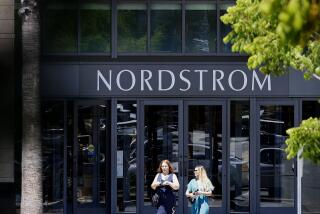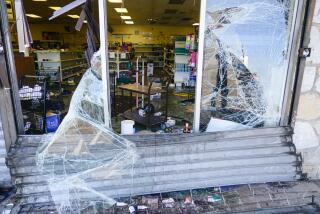Opportunists, Criminals Get Blame for Riots
- Share via
As Los Angeles firefighters and police spent a weary day and night battling arson blazes and looters, stunned residents and business owners grappled with the question of who is torching and pillaging their communities. The answer seemed to be: both criminals and opportunists.
The rampage, which began Wednesday within hours of the verdicts in the Rodney G. King beating case, continued Thursday with scenes reminiscent of a war zone--smoke billowing from dozens of fires, looters hustling out of stores with merchandise, and gunfire echoing through the streets periodically.
But amid the pall, there also was a carnival atmosphere among some participants and onlookers who raced to stricken neighborhoods to watch, join the looting or record events with video cameras. And there was the bizarre picture of gleeful teen-agers and families, as if on a weekend outing, ignoring outnumbered police and loading up on looted goods.
Although young black men constituted many of the rioters and looters, Latinos, Anglos and Asians also took part. Some were as young as 7; others were in their 60s. Mothers brought their children. Gang members were clearly evident, but entire families participated too.
“You had 7- and 8-year-olds all the way up to 60-year-olds--it’s not just gang members,” said Dorothy, a woman who watched the rioting in the Crenshaw area. “You had everyday citizens. . . . I thought about participating myself.”
Many have blamed the violence on gang members, but some officials say a wide spectrum of people took part.
Steve Valdivia, executive director of Community Youth Gang Services, estimated that only about 30% of the rioters and looters were members of gangs. “This was a spontaneous explosion of anger,” he said. “If there were a lot of gang members, you’d have seen a lot more shooting.”
Jim Galipeau, a veteran deputy probation officer in his department’s gang unit, said there was a strong gang presence on the streets but discounted any notion that the activity was organized. “This is just people who are greedy and immoral and opportunistic,” he said. “They don’t give a (expletive) about Rodney King.”
At intersection after intersection, cars crept along jammed streets in stricken areas and motorists leaned out of windows flashing “black power” signs and shouting greetings to each other. Many honked their horns and chanted slogans vilifying police.
Other motorists were more intent on ferrying their stolen prizes. A driver who had looted a furniture store drove along Vermont Avenue in South Los Angeles with a mattress on the roof--cushioning a five-piece dinette set lashed to the top of the car.
In some South Los Angeles neighborhoods, looters could be seen carting away armloads of stolen merchandise while others made multiple trips from their homes using shopping carts to carry the heavy items.
At one auto parts store, flocks of young men could be seen carrying boxes out of the front door while police entered the back way. And as the store was looted, skateboarders and bicyclists whizzed by on the sidewalk. If the police arrived, looters merely waited until they had left and then continued.
In one of the more brazen moves, a driver in Hollywood rammed a pawn shop, backed up 25 feet and rammed it again so that his cohorts could climb inside and grab some valuables. Once loaded, the van sped away. When a patrol car drove by shortly afterward, bystanders who had watched the incident began pelting the police with rocks and bottles.
Two teen-agers--arrested for allegedly shooting at police officers but later released--were being held near 3rd Street and Vermont Avenue. At their sides were two large duffel bags, each stuffed full of clothes stolen from a nearby store. When asked why he was looting, one of the youths said: “Just for fun, you know.”
At John’s Market in the Slauson area, people flocked to the store after several youngsters broke into it. A young mother with three children sent in her 9-year-old daughter to get some diapers for her baby.
A 43-year-old man who had already purchased groceries earlier said he had come back because the merchandise was now free. “I’m getting some food to put on the table,” he said.
In some places, entire families participated in the looting.
“I’m really not like this,” said Karen, a 24-year-old mother who sat in her car at a mini-mall on Crenshaw Boulevard as her daughter and two nieces filled the back seat with video movies and beauty-care supplies stolen from a nearby store.
She laughed when she heard gunfire and sirens in the distance. “Everybody else is grabbing and taking what they can take,” she said. “Why not me? This ain’t stealing. Ain’t nobody in the store. It’s free now.”
As the injury toll rose and property damages escalated, many watching the spectacle on television or in person expressed anger at those responsible for the maelstrom that charred their neighborhoods and ruined businesses from Koreatown to South Los Angeles.
“Blacks did it to themselves this time,” said Ron Marshall, 42, an African-American who owns a business in the Slauson area. “They shot themselves in the foot.”
Said another onlooker: “It’s crazy out here now. It’s really out of control. I mean, I’m Hispanic and we’re killing our own. It’s ridiculous, man.”
Much of the rage and destruction had started innocently enough late Wednesday as vocal--yet peaceful--demonstrators gathered throughout the city after the verdicts. But in a matter of hours, the mood had turned ugly.
Motorists were dragged from their cars by angry crowds and beaten. Shots were fired at bystanders, police, firefighters and the media.
In the Civic Center, hundreds of angry protesters marched through the mostly non-residential area hurling rocks and bottles and shattering windows at police headquarters, courthouses and newspaper offices. Chanting demonstrators burned several automobiles--including a police car outside City Hall--and torched restaurants and businesses before dispersing.
In South Los Angeles, businesses and homes were set afire. Smaller blazes broke out in the city’s Fairfax and Westwood sections and in mostly white communities in the San Fernando Valley. By Thursday night, more fires had broken out in South Los Angeles, Koreatown and Hollywood.
According to some authorities, gang members were suspected of deliberately setting the blazes in a systematic way to frustrate police and firefighters.
Though some of those who smashed windows and set fires said they were acting in response to the King case, others said they were expressing outrage over what they see as a general pattern of racism typified by the verdicts.
Some Korean merchants, who have clashed with black customers in the past, saw their businesses burned. But many black-owned businesses--despite some efforts by owners to identify themselves that way--were not spared.
Lola Davis, whose husband owns a Firestone tire dealership in South Los Angeles, said the couple was watching the news Wednesday night when they saw pictures of their business going up in flames.
“I’m very angry. I’m mad at all of this,” she said Thursday as she sifted through the rubble. “It was a struggle for us to sacrifice. It took 10 years to build this store, and now it’s all gone.”
Meanwhile, an assistant manager at the store, Steve Anderson, said he had just signed papers to purchase a house only hours before the fire destroyed the company--and his job.
“It just didn’t need to happen,” he said. “It’s a catastrophe.”
In a mini-mall at Crenshaw and Stocker Street, a youth minister from Compton was trying to persuade people to cease looting and go home. But no one was paying attention.
While some saw their own lives devastated by the rampage, others mourned for those who took part in the looting and violence.
“‘This is not unity,” said David Scott, 22, a member of the House of Prayer Church in Compton. “This is destroying. This is like getting angry and setting your own house on fire. I’m praying for these people.”
More to Read
Sign up for Essential California
The most important California stories and recommendations in your inbox every morning.
You may occasionally receive promotional content from the Los Angeles Times.










